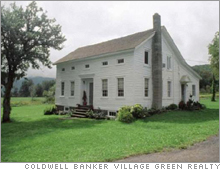Raising an eyebrow colonialExamples of this regional style abound north of New York City.NEW YORK (CNNMoney.com) -- Traveling the back roads of the Hudson Valley and western New England, one often sees houses rendered in an unusual and attractive style. They are mostly clapboard with a distinctive look: a row of very short windows across the entire front of their second stories. Locals call this design "eyebrow colonial," named because the line of short, second story windows call to mind a human's brow.
It isn't, however, an officially recognized name for a house style. "People just refer to their houses as eyebrow colonials," says Doug Bucher, a principle with John W. Waites, an Albany-based firm specializing in preservation architecture. Indeed, some consider the term a misnomer, even a double misnomer. "An eyebrow window is technically a kind of dormer, which these homes don't have," says Ron Burch, senior historian with the New York State Museum in Albany. Eyebrow dormers are small, arched windows emerging from a pitched roof; eyebrow colonials almost always have straight roofs un-adorned by dormers. And technically, colonials are houses built before the American Revolution. Most eyebrow colonials are early to mid-19th century, hence, the double misnomer. Then again, even the term colonial is used very loosely. "Every real estate agent calls everything colonial," says Bucher. In any case, what are called eyebrow colonials have other common traits. The buildings are side-gabled with one-and-a-half stories. The second-story windows often line up directly over the first floor, full-sized windows and front door and are very close to the eaves. The windows tend to be symmetrically distributed across the façade. Inside, the slopes of the steep, pitched roof truncate upstairs rooms. One can stand tall toward the center of the house but have to stoop - or kneel - to approach the walls that contain the short windows. That's why these windows are often called "knee wall" windows. Another term for them is frieze windows, says Burch, because they occupy what would be part of the side entablature in a classical Greek or Roman temple, where an ornamental frieze often is found. From the front, most eyebrow colonials look very much like a clean-cut, story-and-a-half version of the simple, center-hall colonials of the time. There may be pilasters at the corners and sometimes a columned porch. "Most are 18th century," says David Bain, a real estate broker in Kent, Connecticut, where there are quite a few eyebrow colonials. "And there are almost always center chimney structures." Eyebrows are not all of a piece. The short window line can be incorporated in other, well-known home designs. There are eyebrow colonials of a salt-box type, Greek revivals, even Federal-style homes. But most eyebrow colonials are fairly plain, rectangular-shaped buildings, although many have later additions on the sides or back. Families would add on as they grew in size or prosperity. Homes that look like this occur elsewhere; Bucher says they probably originated in New England and moved into the Mid-West with the opening of the Erie Canal back in 1825. But Midwesterners don't seem to use the eyebrow colonial designation. An efficient design The center chimney warmed the upstairs room in winter, an efficiency that hints at why the design was popular in the Northeast. First, the steep roof sheds snow. Too, according to Bucher, it was an economical way to build. You get lots of bang for the buck in terms of space because you only have to add a couple of feet to the walls to produce the extra story. And there are no dormer windows, which are complicated and expensive to build with their extra roofing and flashing, just a straight pitched roof ending just above the windows. The trade-off is that the upstairs rooms, with their ceiling sloped way down near the front walls, are a little awkward, but the windows do provide light and ventilation. Many eyebrow colonials continue to grace the countryside in the beautiful Hudson Valley and Berkshire Mountains. Many have been bought by city dwellers seeking second homes within a short drive of New York and Boston. The new buyers have tended to be respectful of the homes so it is likely that the style, officially recognized or not, will continue to be a lovely part of the landscape there for decades. Photos: On the market - 7 eyebrow colonials |
|

